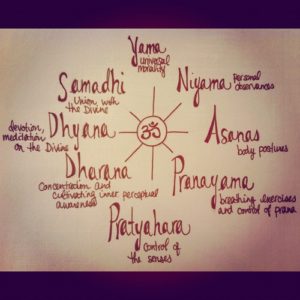Taking yoga off your mat
With school bells in the air, it is a great time to commit to furthering your yoga journey by learning more about the eight limbs of the yogic path. Astanga is Sanskrit for “eight limbs” and those limbs are Yama, Niyama, Asana, Pranayama, Pratyahara, Dharana, Dhyana and Samadhi. The eight limbs of yoga are a process for reaching clarity or enlightenment. The eight limbs are meant to be done gradually, not as individual steps or procedures, but instead as an intricate weaving of threads.
Yama in Sanskrit means “restraint” and how we interact with the outside world, while Niyama is defined as observances or practices we can do. Building an awareness of these limbs helps you take the lessons you learn on your mat — such as non-judgement, acceptance, peace and mindfulness – off your mat.
The five Yamas are:
– Ahimsa: means non-violence and involves more than refraining from physically harming. Violence can take on subtler forms such as ignorance, selfishness, restlessness, anger or negative words or thoughts.
– Satya: means truthfulness, living with integrity and honestly and practicing truthfulness in all matters including speech, thoughts and actions. It means to be honest and non-judgmental in a loving way.
– Asteya: means not stealing and can also mean not taking anything that is not offered. Possessions as well as material items are not the only things that can be taken. Time, energy, feelings, thoughts or ideas can all be taken from their rightful places.
– Aparigraha: means being light on the Earth and letting go of greediness and possessiveness. This yama helps free the practitioner from materialism and envy.
– Brachmacharya: means to practice balance and avoid being a slave to one’s desires.
The five Niyamas are:
– Saucha: means purity and at a primary level refers to cleanliness of both internal and external body. Taking care of basic hygiene and wearing clean clothes, nourishing your body with wholesome foods.
– Santosha: means contentment and to enjoy and accept life. It means being grateful for what you have. We all experience both good times and bad, but we can learn to acknowledge every type of experience with more acceptance, not trying to avoid every feeling…good or bad.
– Tapas: literally means burning impurities and can refer to cleaning blockages from our bodies. Tapas are whatever purifies us physically and mentally. Physical tapas may include cleaning up our diet or doing a basic fast. A strong asana practice is another physical example, through heating up our bodies, using breathing to create heat, we clear impurities. Mental tapas may include meditation, contemplation, journaling or even prayer. Mental tapas can be an exercise in self-discipline and self-restraint. Another translation of Tapas is austerity, or defined in today’s world as simplicity. By focusing on the essential items for our growth we can clean up both our physical and mental space.
– Svadhyaya: means developing a sense of self-awareness – of the world around you and within you. Also, self-observation. It may start intellectually and move into a practice of reflection.
– Isvara Pranidhana: Our practice of the above Niyama, Svadhyaya, may ultimately lead us to realize that a Supreme Being (whatever or whomever you envision that to be) is in control. Isvara represents the infinite being of universal knowledge. Pranidhana means surrender, and together they mean to surrender yourself to something larger than yourself – trusting that this Power will provide exactly what you need when you need it.
If you want to learn more, I highly recommend Deborah Adele’s “The Yamas and Niyamas.” It is a super quick and easy read (also pretty inexpensive through Amazon). For those readers in Columbus, we will discuss the Yamas during a free book club gathering Friday, Sept. 22 from 5:30-7 pm, and the Niyamas Friday, Nov. 3 at the same time. More information will be sent to you once you sign up.

Published September 6, 2017